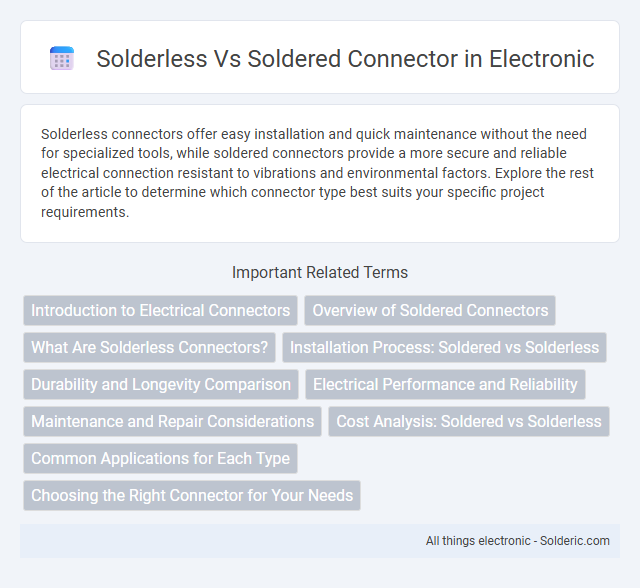Solderless connectors offer easy installation and quick maintenance without the need for specialized tools, while soldered connectors provide a more secure and reliable electrical connection resistant to vibrations and environmental factors. Explore the rest of the article to determine which connector type best suits your specific project requirements.
Comparison Table
| Feature | Solderless Connector | Soldered Connector |
|---|---|---|
| Installation | Quick and tool-free assembly | Requires soldering tools and skills |
| Reliability | Good, but may loosen over time | High, permanent and secure connection |
| Reusability | Reusable and easy to modify | Permanent, not reusable |
| Durability | Moderate, susceptible to vibration | Highly durable, vibration-resistant |
| Application | Prototyping, temporary setups | Permanent installations, high-performance |
| Cost | Generally lower initial cost | Higher cost due to soldering process |
Introduction to Electrical Connectors
Electrical connectors serve as essential components for establishing reliable electrical circuits, available in solderless and soldered types. Solderless connectors enable quick, tool-free connections by clamping wires, ideal for prototyping and low-maintenance applications. Soldered connectors provide permanent, low-resistance joints through molten metal bonding, ensuring durability and signal integrity in high-performance electronics.
Overview of Soldered Connectors
Soldered connectors provide a secure and durable electrical connection by melting solder to join wires and terminals, ensuring strong mechanical and electrical bonds. These connectors are preferred in applications requiring high reliability and resistance to vibration, temperature fluctuations, and mechanical stress. Your choice of soldered connectors impacts the longevity and performance of electronic assemblies, especially in critical, high-precision environments.
What Are Solderless Connectors?
Solderless connectors are electrical connectors that allow secure wire connections without the need for soldering, utilizing crimping, screw terminals, or insulation displacement techniques instead. These connectors provide quick installation, ease of maintenance, and reduce the risk of heat damage associated with traditional soldered joints. Choosing solderless connectors can simplify your wiring projects while ensuring reliable electrical performance.
Installation Process: Soldered vs Solderless
Soldered connectors require heating solder to create a permanent, reliable electrical connection, ensuring strong mechanical stability but demanding skill and tools. Solderless connectors utilize mechanical clamps or crimping methods for quick, tool-light installations ideal for prototyping or field repairs. The solderless process offers faster assembly with less expertise, while soldered connectors provide superior durability and conductivity for long-term applications.
Durability and Longevity Comparison
Soldered connectors offer superior durability and longevity due to a solid metal-to-metal bond that resists vibration and environmental stress better than solderless connectors. Solderless connectors rely on mechanical pressure for the connection, which can loosen over time and degrade signal quality or cause disconnections. For long-term reliability in critical applications, soldered connectors typically provide a more stable and enduring solution for your wiring needs.
Electrical Performance and Reliability
Soldered connectors typically provide superior electrical performance with lower contact resistance and enhanced signal integrity, making them ideal for high-frequency or sensitive applications. Solderless connectors offer ease of installation and maintenance but may exhibit higher contact resistance and potential signal degradation over time due to mechanical wear or environmental factors. Your choice between solderless and soldered connectors should consider the criticality of electrical reliability and the operational conditions of your electronic system.
Maintenance and Repair Considerations
Solderless connectors offer easier maintenance and faster repairs due to their plug-and-play design, eliminating the need for specialized soldering equipment and reducing downtime. In contrast, soldered connectors provide a more secure and reliable electrical connection but require skilled labor and proper tools for repair, making maintenance more time-consuming and potentially costly. Choosing between the two depends on the application's demand for serviceability versus long-term connection stability.
Cost Analysis: Soldered vs Solderless
Solderless connectors generally have higher upfront costs due to specialized materials and manufacturing processes but reduce labor expenses by eliminating soldering time. Soldered connectors typically incur lower component costs but increase total expenses through labor-intensive assembly and potential rework from solder joint failures. Cost efficiency depends on production volume, with solderless favored in high-volume, automated environments and soldered preferred for low-volume or custom applications.
Common Applications for Each Type
Solderless connectors are commonly used in prototyping, temporary connections, and environments where quick installation and reconfiguration are essential, such as home networking or automotive wiring harnesses. Soldered connectors are preferred in applications requiring high reliability and durability, including aerospace, military equipment, and industrial machinery, where vibration resistance and permanent connections are critical. Your choice depends on the balance between ease of assembly and the need for a robust, long-lasting electrical connection.
Choosing the Right Connector for Your Needs
Choosing the right connector depends on the application requirements, with solderless connectors offering quick installation and easy maintenance without specialized tools, while soldered connectors provide superior electrical conductivity and mechanical strength for permanent connections. Consider factors such as frequency of disconnection, environmental conditions, and signal integrity to determine if the flexibility of solderless or the reliability of soldered connectors best suits your project. Your decision will impact long-term performance and ease of use in electronic assemblies.
Solderless vs Soldered connector Infographic

 solderic.com
solderic.com